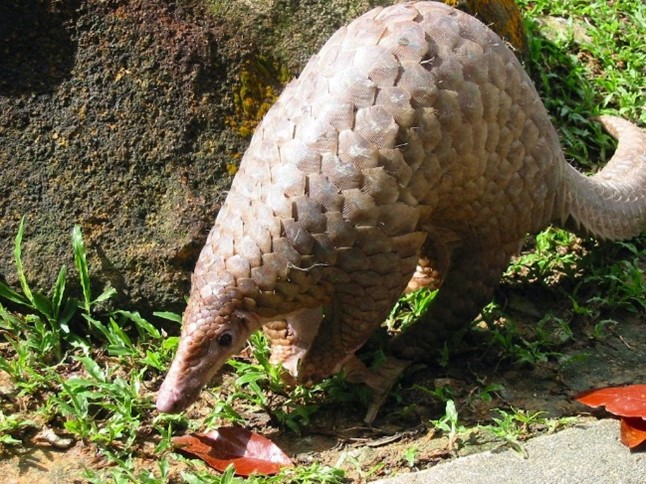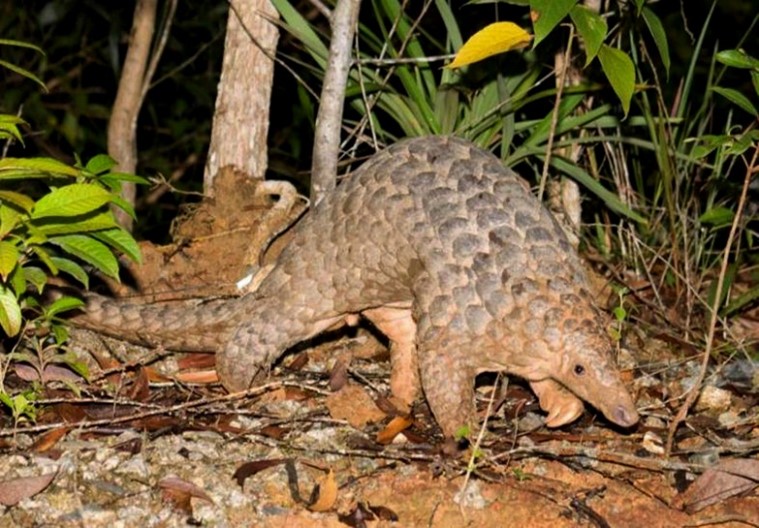5. They See Me Rollin’
The word pangolin is derived from the Malay word ‘penggulung’ which means roller – representative of how the pangolin behaves when it feels threatened, rolling up into an almost impenetrable ball to protect its tender undersides. However, this means that it becomes an easy target for poachers who can simply pick it up and carry it away!
6. Sticky Utensil of Choice
The pangolin’s sticky tongue is its only utensil of choice, to lap up ants and termites, and can extend up to 27 inches (70 cm) long. In comparison, a pangolin’s body width is only between 24 to 62 inches (60 to 160 cm) long. This means that its tongue is almost half its body length! The pangolin has no teeth.
7. Slow Baby Boomers
The pangolin has a low fertility rate of only one to two offsprings per year. As such, the global pangolin population is depleting at a much faster rate than it can recover. Infant pangolins depend and ride on their mothers’ tails for around three to six months.
8. On A Scale Of…
The number of scales on a pangolin is estimated at approximately 900 to over 1000, comprising about 20% of its total body weight. Pangolins’ scales are made of keratin, the same protein that makes up our own hair and nails and the rhinoceros’ horn. There is no scientific evidence that the pangolin’s scales have any medicinal and health benefits. The only part of a pangolin not covered in scales is its delicate underside, which is covered with a few sparse hairs.
9. Asian-African Pangolin Family
There are eight species of pangolins around the world, four of which can be found in Asia: Sunda, Palawan, Chinese and Indian Pangolin. The other four can be found in Africa: Tree, Giant Ground, Cape and Long-tailed Pangolin.
10. International Action
All eight species of pangolins are now prohibited from international trade with greater protections won at the 2017 conference of the Convention on International Trade in Endangered Species (CITES), hosted by the United Nations (UN) Environment. However, the illegal wildlife trading of pangolins for its meat, scales, blood and bones, has not stopped.
What You Can Do To Protect the Pangolin
• Show your support for local conservation and biodiversity efforts
• If you witness any illegal trading or poaching:
- Collect information. Take photos or video evidences of the traps, snares, nets, trapped animals, poachers, and/or their vehicle license plate number.
- Call NParks at 1800-476-1600, if you are inside a protected area, such as a nature reserve or national park. Alternately, you can call the local police.
• Do not buy any pangolin products, such as meat, scales and medicinal products.
• Raise awareness by sharing with your friends and family about the threats to pangolins, and what can they do to help.
• Report your sightings, and contribute resources or media you have to various animal research and welfare groups to assist in research and conservation efforts.
What do I do when I encounter a pangolin?
• Do not be alarmed. These animals are shy and will not attack humans.
• Do not touch, chase or corner them, as they will be frightened from your approach. You are advised to leave them alone.
• Observe them! It is very rare that you will get to see a live pangolin. Share your findings with pangolin research and welfare groups.
Text by Lynn Chan
Photos by Norman Lim and NParks








